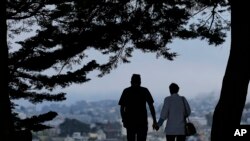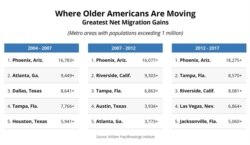Older Americans aren’t moving as much as they used to.
The migration rate of people over 55 has dropped steadily over the past two decades from a high of 6% in 1996, to 4.3% between 2017 and 2018, according to the U.S. Census Bureau.
Moving rates for Baby Boomers — those born between 1946 and 1964 — have rebounded a bit since the Great Recession of 2007-2009, but they remain slightly below pre-recession rates.
“The idea is if the economy's not so good, they may just want to stay working for a little bit more before they retire,” says demographer William Frey of the Brookings Institution.
“Their decision is when can they retire, when is it affordable to retire? And more importantly, from the migration standpoint, does it make sense to to pick up stakes and move somewhere else? If the housing crunch is there, they're not going to have too many bidders for their homes, so the idea of selling your house to move somewhere else is not going to be as easy.”
When they do retire, Baby Boomers are still heading to traditional sunny retirement haunts like Phoenix, Tampa, Riverside [California], Las Vegas and Jacksonville [Florida].
The lure of the big city isn’t calling to these older folks. The cities that experienced the biggest net loss of seniors include New York, Los Angeles, Chicago, Washington and San Francisco.
For all ages, short-distance moves far outnumber long-distance moves, especially for seniors. Those who move a short distance might be interested in being close to their adult children and grandchildren.
Typically, those who move far away are attracted by the weather, lower costs and services geared toward older people. However, there may be movement to back to their kids when they get beyond the early senior years.
“I've got to call them the yuppie elderly, in good health and still have some disposable income, they’ll move to places where they have some amenities for older people,” Frey says. “But when things are not going so well, they may then move back to areas where they have more friends and family that can help take care of them.”










